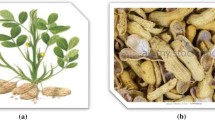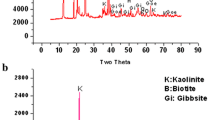Abstract
In this study, response surface methodology (RSM) and Box-Behnken design to improve copper extraction from refractory copper oxide ore were investigated. Based on single factor tests, quadratic polynomial equation to describe the relationship between influencing factors (particle size, leaching temperature, sulfuric acid concentration, leaching time) and copper leaching rate could be obtained by RSM. The optimum parameters determined by the model are as follows: particle size 64.60% − 74 µm, leaching temperature 74.15 °C, sulfuric acid concentration 0.49 mol/L, and leaching time 140.85 min. Under these conditions, experimental copper leaching rate of 85.12% could be achieved, which was very close to the predicted maximum value (85.34%) by the model, indicating the quadratic polynomial model was accurate and reliable. Copper leaching rate increased approximately by five percentage points comparing to the result of single factor tests. This study indicates that response surface methodology is an effective method to optimize experiment conditions and achieve an ideal experiment result.





Similar content being viewed by others
References
Northey S, Haque N, Mudd G (2013) Using sustainability reporting to assess the environmental footprint of copper mining. J Clean Prod 40:118–128
Sverdrup HU, Ragnarsdottir KV, Koca D (2014) On modelling the global copper mining rates, market supply, copper price and the end of copper reserves. Resour Conserv Recycl 87:158–174
Zhang DJ, Leng YY (2013) Deposit types and geological characteristics of copper deposits in Zambia. Geol Explor 49(3):570–576
Liu JC, Mo JP, Liu C (2016) Genesis of copper deposits in copperbelt of Zambia. Miner Resour Geol 30(2):203–207
Liu RQ, Feng SY (2013) Zambia’s major ore resources and typical deposits. Resour Ind 15(3):57–61
Wang GR, Yang HY, Tong LL, Liu YY (2019) Research on technological mineralogy of copper oxide ore in Luanshya, Zambia. J Northeast Univers (Nat. Sci) 40(3):350–355
Yu BQ, Sun CB, Kou J (2021) Process mineralogical study on refractory copper oxide ore in Zambia. Metal mine 536:110–114
Yao GH, Yan JL, Wang HJ, Wu AX (2010) Study on heated agitation leaching of copper oxide ore with high mud content. Science paper online 5(11):855-860
Hu M, Li XH, Zhang GH, He L, Ji SS, Ding JN (2015) Enhanced leaching experimental study on high combination rate clay oxide copper ore. China Mining Magazine 24(10):160-163
Sun X, Chen B, Yang X et al (2009) Technological conditions and kinetics of leaching copper from complex copper oxide ore. J Cent South Univ Technol 16:936–941
Guan S, Deng F, Huang SQ, Liu SY, Ai LX, She PY (2017) Optimization of magnetic field-assisted ultrasonication for the disintegration of waste activated sludge using Box-Behnken Design with response surface methodology. Ultroson Sonochem 38:9–18
Silva E, Rogez H, Larondelle Y (2007) Optimization of extraction of phenolics from Inga edulis leaves using response surface methodology. Sep Purif Technol 55:381–387
Liyanapathirana C, Shahidi F (2005) Optimization of extraction of phenolic compounds from wheat using response surface methodology. Food Chem 93:47–56
Manzato L, Takeno ML, Pessoa-Junior WAG, Mariuba LAM, Simonsen J (2018) Optimization of cellulose extraction from jute fiber by Box-Behnken design. Fiber Polym 19:289–296
Shahraki S, Karamoozian M, Azizi A (2018) Desulfurization of coal by HNO3 leaching: optimization of influential factors using Box-Behnken design. J Min Environ 9(3):657–665
Agacayak T, Ahmed MT (2020) Optimization and modeling of leaching parameters affecting nickel dissolution from lateritic ore in Eskisehir (Mihaliccik- Yunusemre) using Box-Behnken experimental design. J Environ Anal Chem 7(1):1–7
Box GEP, Hunter JS, Hunter WG (2005) Statistics for experimenters: design, innovation, and discovery, 2nd edn, Wiley, 672p
Yang LS, Wang JX, Sun XH et al (2019) Multi-objective optimization design of spiral demister with punched holes by combining response surface method and genetic algorithm. Powder Technol 355:106–118
Gosu V, Arora S, Subbaramaiah V (2020) Simultaneous degradation of nitrogenous heterocyclic compounds by catalytic wetperoxidation process using Box-Behnken design. Environ Eng Res 25(4):488–497
Acknowledgements
Sample preparation and characterization by the University of Science and Technology Beijing for this paper are gratefully acknowledged.
Author information
Authors and Affiliations
Corresponding author
Ethics declarations
Conflict of Interest
The authors declare no competing interests.
Additional information
Publisher's Note
Springer Nature remains neutral with regard to jurisdictional claims in published maps and institutional affiliations.
Rights and permissions
Springer Nature or its licensor holds exclusive rights to this article under a publishing agreement with the author(s) or other rightsholder(s); author self-archiving of the accepted manuscript version of this article is solely governed by the terms of such publishing agreement and applicable law.
About this article
Cite this article
Yu, B., Zhan, D., Liu, J. et al. Response Surface Method Optimization to Improve Copper Extraction from Refractory Copper Oxide Ore. Mining, Metallurgy & Exploration 39, 2221–2228 (2022). https://doi.org/10.1007/s42461-022-00670-5
Received:
Accepted:
Published:
Issue Date:
DOI: https://doi.org/10.1007/s42461-022-00670-5




